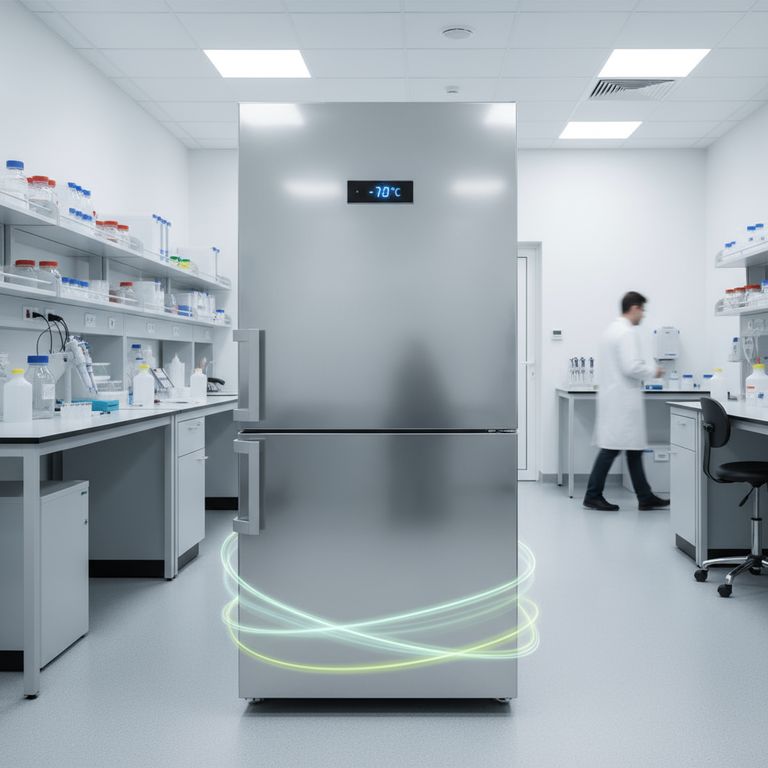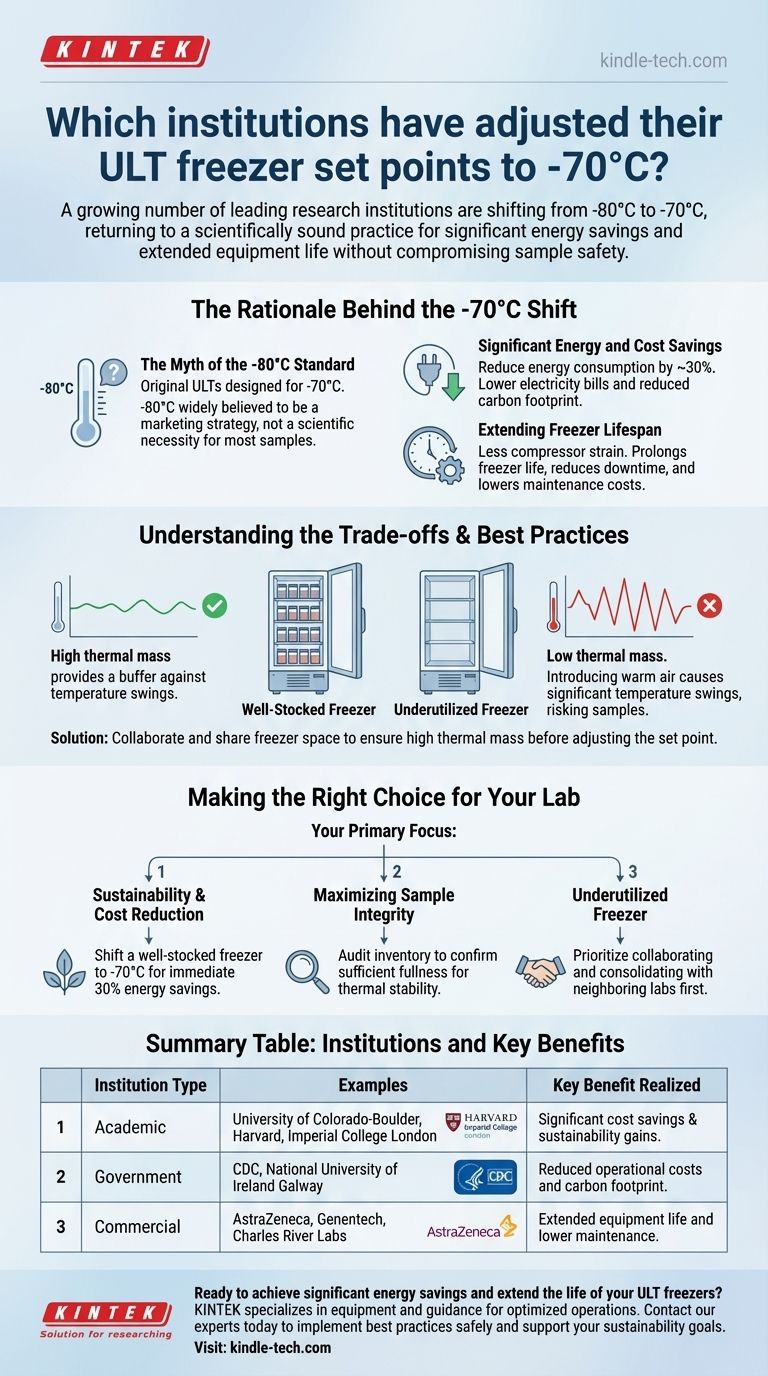A growing number of leading research institutions have successfully adjusted their ultra-low temperature (ULT) freezer set points from -80°C to -70°C. This list includes prominent academic, government, and commercial organizations such as the University of Colorado-Boulder, UC Davis, Harvard, Dartmouth, UC Santa Barbara, AstraZeneca, Charles River Labs, Genentech, the CDC, Imperial College London, and the National University of Ireland Galway.
The shift to a -70°C set point is not merely a trend but a return to a scientifically sound practice. It allows labs to achieve significant energy savings and extend equipment life without compromising sample safety, provided the freezer is adequately stocked.

The Rationale Behind the -70°C Shift
The move to a warmer, yet still ultra-low, temperature is driven by clear operational and financial benefits, challenging a long-held but scientifically unsupported standard.
The Myth of the -80°C Standard
The -80°C setting was not established based on a demonstrated scientific need for the vast majority of biological samples.
Original ULT freezers were designed for -70°C. The shift to -80°C is widely believed to have been a marketing strategy by manufacturers to differentiate their products, rather than a decision based on improved sample preservation.
Significant Energy and Cost Savings
Adjusting a ULT freezer from -80°C to -70°C can reduce energy consumption by approximately 30%.
This simple change directly translates into lower electricity bills and a reduced carbon footprint for the institution, aligning research operations with sustainability goals.
Extending Freezer Lifespan
Maintaining a -80°C temperature places immense strain on a freezer's compressors, leading to more frequent failures.
By setting it to -70°C, the system works less hard. This prolongs the life of the freezer, resulting in less equipment downtime, lower maintenance costs, and a reduced risk of catastrophic failure that could compromise years of research.
Understanding the Trade-offs and Best Practices
While the benefits are clear, a successful transition to -70°C requires an understanding of one critical factor: thermal mass.
The Importance of Freezer Density
A ULT freezer’s ability to maintain a stable temperature when the door is opened depends on its thermal mass—the total mass of frozen material inside.
A partially empty freezer has low thermal mass. When opened, the introduction of warm, ambient air can cause significant temperature swings that may be detrimental to sensitive samples.
The Risk of Underutilized Freezers
Raising the set point to -70°C on a sparsely filled freezer is not recommended. The potential for wider temperature fluctuations outweighs the energy-saving benefits.
Your primary goal must always be the protection and integrity of your stored samples.
The Solution: Collaboration and Sharing
If your freezer is not full, the best practice is to consolidate and share freezer space with another lab.
By ensuring the freezer is well-stocked, you increase its thermal mass, which provides a crucial buffer against temperature swings. This allows you to safely adjust the set point and realize the benefits of "chilling up."
Making the Right Choice for Your Lab
Follow these guidelines to make an informed, evidence-based decision about your ULT freezer settings.
- If your primary focus is sustainability and cost reduction: Shifting a well-stocked freezer to -70°C is one of the most impactful actions you can take, offering an immediate 30% energy savings.
- If your primary focus is maximizing sample integrity: Before making any change, audit your freezer's inventory to confirm it is sufficiently full to maintain thermal stability.
- If your freezer is currently underutilized: Prioritize collaborating with neighboring labs to consolidate contents before adjusting the temperature set point.
By understanding the principles of thermal mass, you can confidently adopt this best practice, benefiting both your research and your institution's resources.
Summary Table:
| Institution Type | Examples | Key Benefit Realized |
|---|---|---|
| Academic | University of Colorado-Boulder, Harvard, Imperial College London | Significant cost savings & sustainability gains |
| Government | CDC, National University of Ireland Galway | Reduced operational costs and carbon footprint |
| Commercial | AstraZeneca, Genentech, Charles River Labs | Extended equipment life and lower maintenance |
Ready to achieve significant energy savings and extend the life of your lab's ULT freezers?
At KINTEK, we specialize in providing laboratories with the equipment and expert guidance needed to optimize operations for efficiency and sample safety. Whether you're considering the shift to -70°C or need reliable ULT freezers and consumables, our team is here to help you implement best practices safely.
Contact our lab equipment experts today to discuss how we can support your sustainability and cost-reduction goals!
Visual Guide

Related Products
- 808L Precision Laboratory Vertical Ultra Low Temperature Freezer
- 158L Precision Vertical Ultra Low Freezer for Laboratory Applications
- 938L Vertical Ultra Low Temperature Freezer for Advanced Laboratory Storage
- 208L Advanced Precision Laboratory Ultra Low Temperature Freezer for Cold Storage
- 608L Essential Laboratory Ultra Low Temperature Freezer For Critical Sample Preservation
People Also Ask
- What is the price range for ultra low temperature freezers? Protect Your Samples with the Right Investment
- What makes Ultra-Low Temperature freezers energy efficient? Key Design & Operational Strategies
- Where are ultra low temperature freezers commonly used? Essential for Labs, Hospitals, and Biotech
- In what fields are ultra low temperature freezers most commonly used? Essential for Biomedical, Clinical, and Research Labs
- What are ultra low temperature freezers used for? Preserving Critical Biological Samples for Decades



















